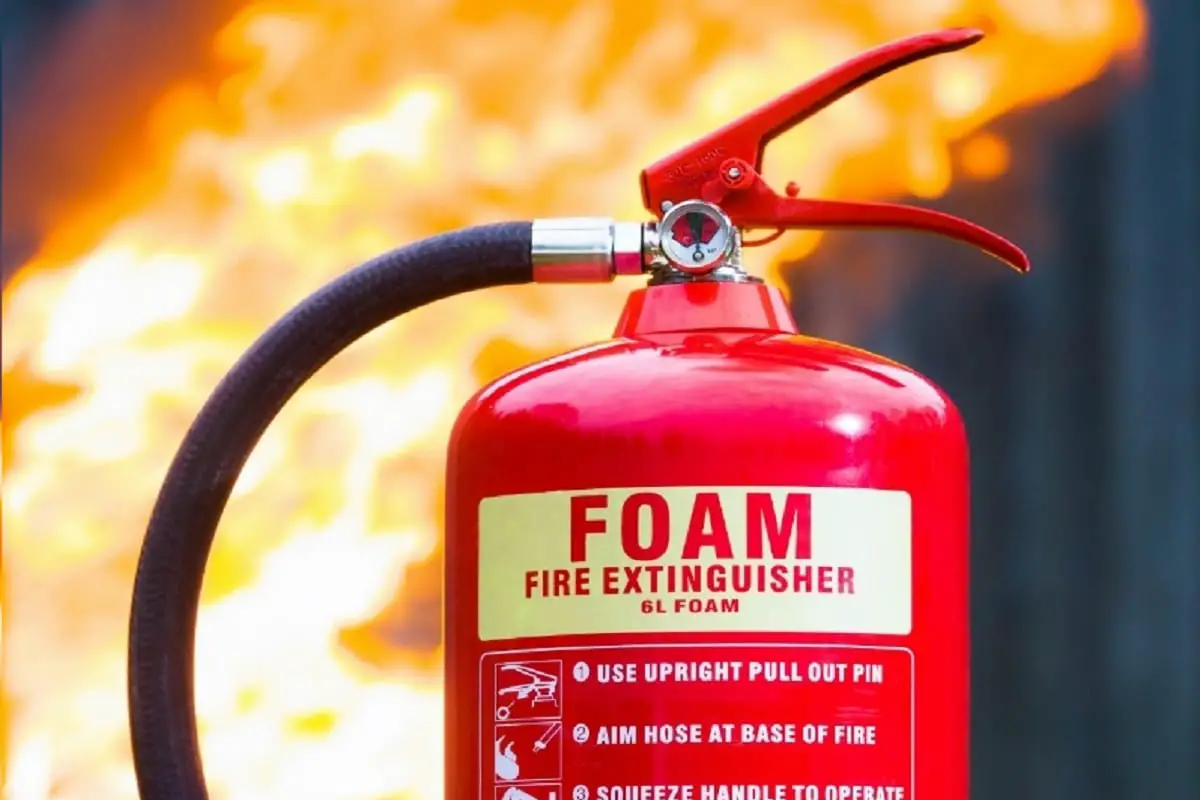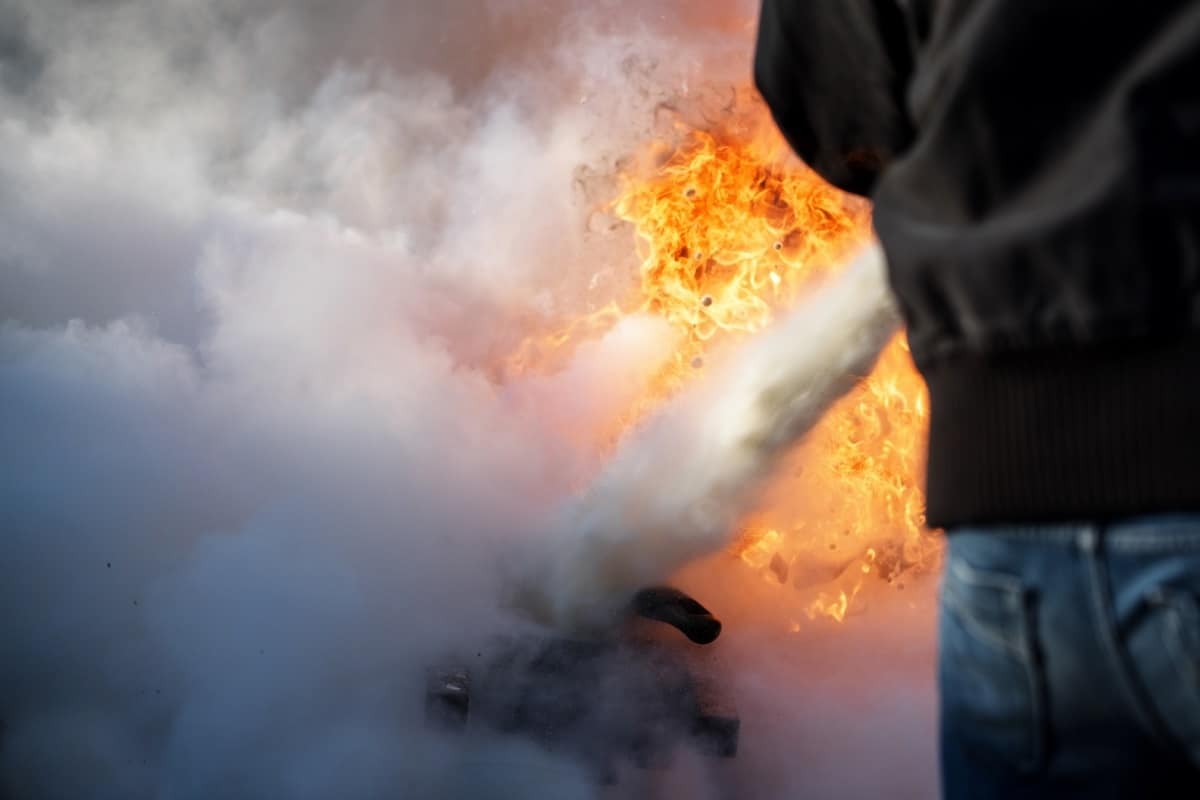There are several different kinds of fire extinguishers, and each is used to put out a certain type of fire. One of them is a foam fire extinguisher. Foam fire extinguishers differ from other fire extinguishers because they ensure that the inflamed surfaces remain cool long after the fire has been put out. While this prevents the fire from reigniting, the foam is a hassle to clean up and might even be toxic.
This article explores the foam released from foam-based fire extinguishers in detail – what it is, potential toxicity, effectiveness, and how to clean it up afterward.
What Is Fire Extinguisher Foam Made Of?
A fire extinguisher foam is a low-density fluid made up of small air-filled water bubbles. Essentially, it has three ingredients mixed in specific proportions: water, foam, and air.
Foam extinguishers carry a cream-colored label, whereas wet chemical and water mist fire extinguishers may have labels of yellow and white colors, respectively.
For decades, foam has been used to extinguish fires from flammable or combustible liquids.
Foam works by:
- Separating the flame source from the oxygen supply
- Suppressing the smokes or vapors to keep the flames from spreading
- Cooling the source of fire to prevent reignition
What Types of Fires Does Fire Extinguisher Foam Put Out?
Foam fire extinguishers are used on Class A and Class B fires.
- Class A fires are fires from carbon-based solids like paper, wood, or cloth.
- Class B fires are fires from flammable liquids like petrol, diesel, paraffin, or oil.
Usually, foam-based fire extinguishers are most suited to putting out liquid fires like gasoline or diesel. They do so by sealing the liquid surface to prevent the vapors from spreading. Alternatively, they can be used to extinguish solid-based fires such as those caused by wood or paper as well.

How Effective Is Fire Extinguisher Foam?
To understand how foam extinguishers put out fires, we need to know how fires burn in the first place. There are four elements to a burning flame: heat, fuel, air or oxygen, and a chemical chain reaction. Interfering with any of these elements can stop the fire.
A foam based fire extinguisher does obstruct a fire by:
- Covering the burning surface and cutting off its oxygen supply.
- Separating the ignited object from the source of the flame and preventing a chain reaction.
- Cooling all heated surfaces.
- Preventing the release of flammable liquids that can mix with the air.
Fire Extinguishers: Foam vs. Powder vs. Water
| Foam Extinguisher | Powder Extinguisher | Water Extinguisher | |
| How Do They Work? | They throw a layer of foam on the source and objects of the fire. | They work by creating a layer on top of the fire and prevent its access to oxygen. | They work by cooling the fire, soaking the heated objects, and absorbing heat from burning objects. |
| Pros | They provide an added benefit of ensuring that the fire does not reignite after being put out. | They are inexpensive for how effective they are and come in a range of different sizes from 1 to 9 kg. | They are the easiest to maintain. |
| Cons | They leave a residue that is harder to clean, especially from kitchen appliances. | They lack a cooling effect, and the flames might reignite. Plus, there’s a chance they might damage machinery and furniture. | They’re heavier on surfaces and quicker to boil on heated objects. |
Foam extinguishers are more efficient than water, dry chemical, and CO2 extinguishers because water extinguishers are heavier and quick to boil.
Is Fire Extinguisher Foam Toxic?

The foams from a fire extinguisher are usually non-toxic. However, they leave behind chemicals that can irritate your lungs, eyes, and throat and are possibly carcinogenic in high concentrations and prolonged exposure.
Fire extinguisher foam can pose a risk to your safety if:
- You improperly wash a kitchen surface or utensils and end up consuming the foam
- You accidentally inhale the foam vapors in a confined space, where there is a high chance that they have reacted with some surfaces or toxic chemicals have not had a chance to evaporate.
To ensure safety while cleaning up fire extinguisher foam, wear gloves, a dust mask, and goggles, and make sure you clean up with a damp cloth or a paper towel.
How to Clean Up Fire Extinguisher Foam?
Because of certain safety risks that are associated with consuming the residue of the foam from a fire extinguisher, make sure you adhere to the following protective measures:
1. Wear Protective Gear
Wearing plastic or disposable gloves before starting the cleaning process is crucial. Gloves will keep your hands clean of the foam residue. Make sure you dispose of your gloves immediately after usage. This keeps you from accidentally touching your face or mouth and consuming or inhaling the foam on accident.
2. Soak the Foam with Paper Towels
Paper towels or any other absorbent pieces of cloth will soak up the foam residue, which is vital to clear the area before washing it with water. Adding water first might spread the foam into the nooks and crannies that you might not be able to reach.
3. Clean the Surface with Water
After you’ve cleaned the major chunks of the foam residue, dab a piece of cloth with water and wipe the surface. Alternatively, spill a bit of water on the surface and clean it off with a rag. It’s important to be thorough in this stage because you don’t want a carcinogen to be trapped in any of the countertops you use every day.
4. Throw All Cleaning Materials Away
After you’ve ensured that the surface is clean, take the paper towels and rags used, seal them in a plastic bag and throw them away.
The Take-Away
No one wants to have to use a fire extinguisher – but if the inevitable happens, you need to be prepared for all the steps you need to take. This includes getting all the information you can about the fire extinguisher you’re going to use to douse the flame and how to clean the residue left in the wake of the event.
